
Working around Heavy Construction Equipment
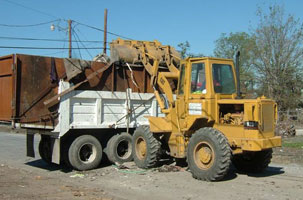 As trainers of your students and young workers, you are responsible for educating them on workplace health and safety
including (but not limited to): the importance of learning in safety meetings and other trainings, and complying with
the rules and regulations. To reduce the risk of injury and increase productivity, see the information below:
As trainers of your students and young workers, you are responsible for educating them on workplace health and safety
including (but not limited to): the importance of learning in safety meetings and other trainings, and complying with
the rules and regulations. To reduce the risk of injury and increase productivity, see the information below:
Cal/OSHA has a number of regulations related to the safety in construction - found in Title 8 of the California Code of Regulations (T8CCR).
The specific Cal/OSHA safety requirements that apply to your trainees depends on the types of construction activities they will actually be performing. The complete set of Title 8 regulations can be found at:
www.dir.ca.gov/samples/search/query.htm
The following is a brief overview and summary of the regulations in Title 8 related to safety when working around heavy equipment. Not all of the applicable Title 8 regulations are given below.
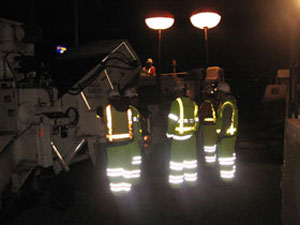 Provide and require employees exposed to vehicular traffic to wear high visibility clothing -
T8CCR Section 1590(a)(5), and retroreflective material
Section 1599(d),
Section 1598(c),(d) and (e)
Provide and require employees exposed to vehicular traffic to wear high visibility clothing -
T8CCR Section 1590(a)(5), and retroreflective material
Section 1599(d),
Section 1598(c),(d) and (e)- A system of traffic control is required to abate traffic hazards - T8CCR Section 1590(a)(4)
- Traffic control must conform with the "California Manual on Uniform Traffic Control Devices for Streets And Highways, September 26, 2006."
- Back up alarms must be audible from 200 feet away or flagger in clear view of the operator shall direct the backing operation T8CCR Section 1592(a)
- Equipment operators must be aware of workers on foot - T8CCR Section 1592(e)
- All vehicles must be inspected each work day for malfunctions. All repairs must be made before vehicles are placed in service. - T8CCR Section 1597(j), Section 1593(d)
- Seatbelts must be in good working order. Employer shall require the use of seat belts - T8CCR Section 1596(g), Section 1597(h)
- Roll over protection structures (ROPS) on vehicles and heavy equipment must be provided and used T8CCR Section 1596(a)
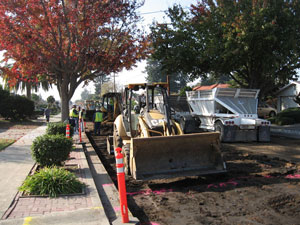 Ensure that all students and young workers can demonstrate they are able to work safely around heavy construction equipment.
Always closely supervise students and young workers.
Ensure that all students and young workers can demonstrate they are able to work safely around heavy construction equipment.
Always closely supervise students and young workers.
Planning
- Set up a preconstruction meeting inviting all contractors to discuss ways to coordinate work activities, identify potential hazards, and means to eliminate or reduce them
- Develop a process for reviewing incidents and close calls. Identify hazards and ways to correct them
- Develop diagrams to show how construction vehicles and heavy equipment will enter, move, and leave the work zone
- Design the workspace so that backing up and blind spots are minimal
- Establish ways to provide for well lit work areas
Traffic Control
- Prevent unauthorized access to worksite.
- Establish parking areas for workers and visitors
- Install barricades or other barriers to clearly delineate traffic routes and prevent vehicles from coming into the work zone
- Designate a single traffic control person to authorize, monitor, and direct the movement of vehicles including backing up
- Provide alternate routes for workers on foot to access the work area, if possible
- Authorize the traffic control supervisor to temporarily stop work until traffic congestion is under control or eliminated
Train students and young workers
- Review with them their information on What Can Happen to You and How to Keep Yourself Safe when working around heavy construction equipment
- Hold daily toolbox meetings at the job site to highlight potential dangers of today's tasks. Discuss close calls
- To recognize and avoid the hazards of working on foot around vehicles and heavy construction equipment by staying away and working at safe distances
- To recognize and stay away from the blind spots of heavy equipment and vehicles
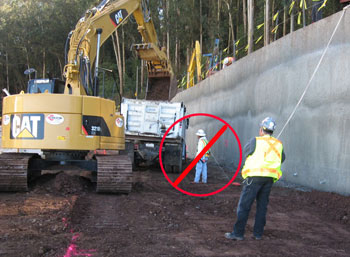
- To be alert to potential hazards that may be created by another contractor's employees
- To work within the line of sight of the equipment operator and maintain visual contact with the operator
- To wear high visibility safety clothing including retroreflective gloves, arm bands, and other accessories. This is critical under poor lighting and bad weather conditions
Work Safer
- Schedule work tasks to keep workers on foot out of areas where heavy equipment and construction vehicles are present whenever possible
- Use sensing units on heavy equipment to detect workers on foot
- Encourage communication, e.g., hand signals, two way radios for employees assigned to watch for safety in the work zone or employees on foot talking to the equipment operator
- Ensure backup alarms, horns on construction equipment are tested daily and function effectively. Instruct equipment operators to use these devices to call the attention of workers on foot
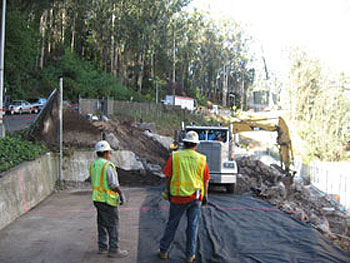 Encourage operators of heavy equipment and construction vehicles to:
Encourage operators of heavy equipment and construction vehicles to:
- move equipment only after positive visual contact (seeing each others eyes) has been made and confirmed with workers on foot
- always observe jobsite speed limits and reduce speed when workers on foot are nearby
February 2010

